We're approaching one of the prime photography seasons in the northern hemisphere. Summer brings warm weather and vacations. More daylight. Children playing outside. If you're thinking about upgrading your photo gear for the summer, now is a good time to do some research. Many TechByter Worldwide subscribers are interested in photography, so I occasionally spend some time on the subject. Usually it's software that catches my eye, but this time I thought hardware might be a good topic. After all, Adobe Lightroom and Photoshop are probably all that you need to know about software. For that reason, today's program is all about lenses.
Although cameras that are built into smart phones are astonishingly good, serious photography still requires a serious camera. Professional and amateur photographers alike still gravitate toward single-lens-reflex cameras because they offer through-the-lens viewfinders and interchangeable lenses.
New types of cameras have interchangeable lenses but are smaller than traditional SLRs because they have electronic viewfinders, smaller sensors, or both. For this article, I've decided to stick with standard SLRs. Even so, there are 2 types of digital SLRs: full sensor and cropped sensor.
The full sensor cameras have a sensor that's the same size as 35mm film (36mm by 24mm) and cropped sensor cameras (also called APS-C) have a sensor that's 22.2mm by 14.8mm (Canon) or 23.5mm by 15.6mm (everybody else). Because of this, there is a "magnification factor" for cropped sensor cameras. Compared to a 35mm film camera, a 50mm lens on a cropped sensor camera is the equivalent of a 75mm lens (or, on a Canon camera, the equivalent of an 80mm lens).
If you think of 50mm as a "normal" lens based on your experience with 35mm cameras, you'll be surprised by the images you obtain with a 50mm lens on a cropped sensor camera. Considering a lens's angle of view is the more accurate way to determine what the lens sees, but often it's better to simply use the multiplication factor to describe a lens in terms of its 35mm film camera equivalence and that's what I'll do here.
Lenses come in 2 primary varieties, fixed length (prime) lenses and zoom lenses. Beyond that there are additional categories.
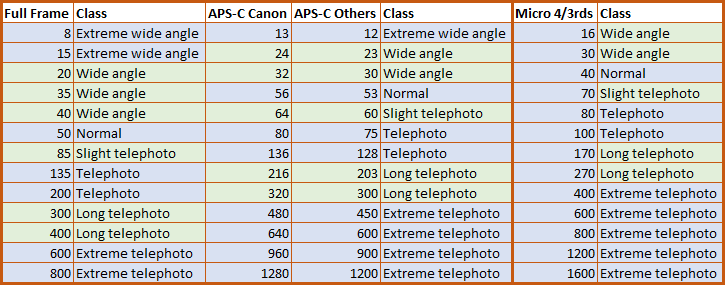
Most photographers tend to prefer either wide-angle views or telephoto views. For example, my natural vision seems to be more in the telephoto range and the lenses in my case support that statement. But I also sometimes like to use extreme wide angle lenses. When I do, though, it's more difficult for me to achieve my photographic vision.
Full-frame sensors favor photographers with a wide-angle world view and APS-C cropped sensors (and micro four thirds sensors) favor those of us with telephoto eyes. Because of the magnification factor, it's nearly impossible to find extreme wide angle lenses. At the other end of the spectrum, a lens that would fit in the long telephoto category on a full-frame sensor becomes an extreme telephoto on a cropped-sensor camera.
Another sensor format, Micro Four Thirds, essentially doubles the focal length of a lens on a full-frame sensor. A 15mm lens that would be an extreme wide angle lens on a full-frame sensor would be the equivalent of a 24mm lens on an APS-C camera (wide angle) and a 40mm lens (normal) on a Micro Four Thirds camera.
Lenses are expensive, particularly at the short and long extremes. Nikon and Canon lenses often cost several thousand dollars and at the extremes it's even worse. Canon has an 800mm telephoto lens that's priced at $13,000. At the other end of the spectrum, there's the 8-15mm lens for just $1249.
When I started getting interested in photography, shortly after dirt was invented and when Japan was beginning an effort to displace Germany as the manufacturer of high-quality photographic equipment, cameras typically came with a 50mm lens. On a 35mm film camera, that was "normal". Zoom lenses were slow, heavy, expensive, and not particularly sharp. A lot has changed since then.
Today's cameras invariably come with a relatively fast, small, and sharp zoom lens that provides coverage from moderate wide angle to moderate telephoto. These "kit" lenses (called that because they're in the original kit), while not outstanding in any way, are acceptable in almost every way. The maximum aperture varies over the zoom range of the lens, something that would have been unacceptable when photographers had to use hand-held meters. Now that cameras measure the amount of light coming through the lens, that's no longer an issue.
Because variable apertures are acceptable, the kit lenses can be made smaller than lenses that need to maintain an aperture over the entire zoom range. They're lighter and they're less expensive.
Single-focal-length ("prime") lenses are less common these days because of improvements in zoom lens technology. Buying a lens that has a single focal length might seem like a bad idea, but prime lenses have advantages: They're smaller and lighter than zoom lenses. They usually have larger maximum apertures. They're almost always sharper than zoom lenses. But two zoom lenses can take the place of a bag full of prime lenses.
Let's define a few terms:
Consider a couple of zoom lenses from Canon:
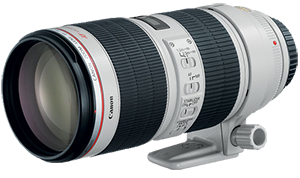 Canon EF 70-200mm f/2.8L IS II USM Telephoto Zoom Lens: This is a lens that's intended for professionals. All moving elements are inside, which makes the lens somewhat impervious to weather. It has a constant aperture and that aperture is a fast f/2.8. The lens has image stabilization built in, will cover a full-frame sensor, costs $2000, and weighs 3 pounds.
Canon EF 70-200mm f/2.8L IS II USM Telephoto Zoom Lens: This is a lens that's intended for professionals. All moving elements are inside, which makes the lens somewhat impervious to weather. It has a constant aperture and that aperture is a fast f/2.8. The lens has image stabilization built in, will cover a full-frame sensor, costs $2000, and weighs 3 pounds.Click any of the smaller images for a full-size view.
Press Esc to dismiss the larger image.
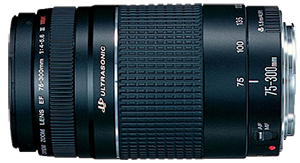 Canon EF 75-300mm f/4-5.6 III USM Telephoto Zoom Lens: This lens covers a longer range and stretches all the way to 300mm, so you might expect it to cost more. But it also has a variable aperture, the optics tube is plastic, some of the moving parts are exposed, and there's no image stabilization. It weighs just a little over a pound and you can find this lens on sale for less than $200.
Canon EF 75-300mm f/4-5.6 III USM Telephoto Zoom Lens: This lens covers a longer range and stretches all the way to 300mm, so you might expect it to cost more. But it also has a variable aperture, the optics tube is plastic, some of the moving parts are exposed, and there's no image stabilization. It weighs just a little over a pound and you can find this lens on sale for less than $200.Which is the "right" lens? Some people own both of them, using the larger and heavier lens in more rugged shooting conditions or when a shallow depth of field is important. The less expensive lens zooms further (and, on a cropped sensor camera, is the equivalent of a 480mm lens). So they're both "right", depending on conditions.
That is the primary point about lenses. Every lens made is right for some purpose; you just need to figure out which lens is right for which purpose.
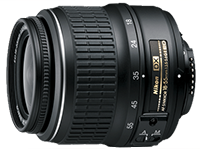 Standard Zoom: These lenses are considers "walk around" lenses, the type of zoom that you might put on a camera when you're just walking around. Expect the lens to cover a range from moderate wide angle to moderate telephoto. The kit lens that comes with the camera is in this category, but lenses that include a wider range are also available and can usually be purchased with the camera instead of the kit lens. APS-C lenses in this category would range from about 18mm to 55mm for kit lenses and 18mm to 135mm for upgrades.
Standard Zoom: These lenses are considers "walk around" lenses, the type of zoom that you might put on a camera when you're just walking around. Expect the lens to cover a range from moderate wide angle to moderate telephoto. The kit lens that comes with the camera is in this category, but lenses that include a wider range are also available and can usually be purchased with the camera instead of the kit lens. APS-C lenses in this category would range from about 18mm to 55mm for kit lenses and 18mm to 135mm for upgrades.
Wide-angle Zoom: These are lenses that can often be used well for landscape photography and interior architectural images. These lenses will often range from 10mm to 20mm for APS-C cameras.
Macro Lens: For those who like to capture extreme close-ups, this is a great choice. Insects, flowers, stamps, and coins are all good subjects for macro lenses. These are usually single-focal-length lenses, often 50mm or 100mm. The 100mm macro lens would allow the photographer to be further from the subject being photographed.
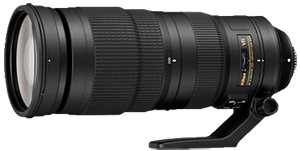 Telephoto Zoom: Photographers who have a standard zoom lens often add a telephoto zoom as the next lens in their bag. For APS-C cameras, common ranges are 55mm to 200mm and 75mm to 300mm. These lenses give extra reach for wildlife photography.
Telephoto Zoom: Photographers who have a standard zoom lens often add a telephoto zoom as the next lens in their bag. For APS-C cameras, common ranges are 55mm to 200mm and 75mm to 300mm. These lenses give extra reach for wildlife photography.
Super-zoom: These are the ultimate walk-around lenses. Manufacturers attempt to create a lens that covers a range from wide angle to long telephoto. There are significant shortcomings in sharpness and speed with these lenses. They're also usually large and heavy, but a single super-zoom will still be lighter than a standard zoom and a telephoto zoom. These lenses generally cover a range from 18mm to 250mm or even 300mm.
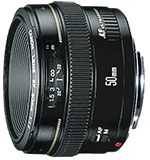 Prime Lenses: You might want to have one or two of these lenses, too, because they have large maximum apertures that make them useful in low-light conditions or for images where you want a very shallow depth of field. A 35mm prime lens will provide a "normal" field of view on an APS-C camera while a 50mm lens will provide a similar view on a full-frame camera. The 50mm lens is an outstanding portrait lens for APS-C cameras because it is a short telephoto for that format.
Prime Lenses: You might want to have one or two of these lenses, too, because they have large maximum apertures that make them useful in low-light conditions or for images where you want a very shallow depth of field. A 35mm prime lens will provide a "normal" field of view on an APS-C camera while a 50mm lens will provide a similar view on a full-frame camera. The 50mm lens is an outstanding portrait lens for APS-C cameras because it is a short telephoto for that format.
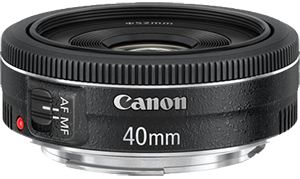 Pancake Lenses: I'm not a big fan of these lenses, but they do have good uses. These are small, thin lenses with single focal lengths. Their primary advantage is the ability to make the camera smaller. If you have a Micro Four Thirds camera, you'll find a variety of pancake lenses.
Pancake Lenses: I'm not a big fan of these lenses, but they do have good uses. These are small, thin lenses with single focal lengths. Their primary advantage is the ability to make the camera smaller. If you have a Micro Four Thirds camera, you'll find a variety of pancake lenses.
Ultra-wide angle lenses can be fun. When 35mm cameras ruled, ultra-wide would be 10mm to 12mm. In a world where most amateurs (and some professionals) use cameras with APS-C (cropped) sensors, 10mm equates to about 16mm and if you want an ultra-wide view, you'll need a lens that's in the 8mm range. The prices will astound you, but there are alternatives.
Consider the Canon EF 8-15mm f/4. This equates to about 13mm to 24mm in film camera equivalences. I would love to have this lens, but it costs $1249.00. That's a lot to pay for a lens that won't see a lot of use.
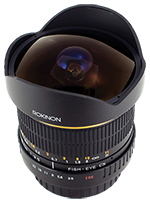 Then I noticed the Rokinon 8mm f/2.8 UMC with a Canon mount. It equates to about 13mm on a film camera. It's a fixed-length lens and it doesn't include the Canon lens's auto-focus, zoom, or auto-exposure features. But it's also priced at just $258.26.
Then I noticed the Rokinon 8mm f/2.8 UMC with a Canon mount. It equates to about 13mm on a film camera. It's a fixed-length lens and it doesn't include the Canon lens's auto-focus, zoom, or auto-exposure features. But it's also priced at just $258.26.
While I couldn't justify paying nearly $1300 for a lens I would use infrequently, I could justify shelling out $260. Auto-exposure? That would be nice, but it's not worth $1000. Auto-focus? This would also be nice, but it's also not worth $1000 -- particularly with an ultra-wide angle lens that keeps almost everything in focus regardless of how far it is from the camera's focal plane.
Rokinon is a Korean manufacturer that cuts a lot of corners. The lens is fixed length, not zoom. There's no auto-focus. There's no auto-exposure. You can't run the lens at its maximum aperture without significant image degradation. But the build quality is surprisingly good, the depth of field at 8mm all but eliminates any question about focusing, and if you're using an ultra-wide lens, you'll probably have it on a tripod and exposure will be something you'll set manually.
There's no question that a $1300 lens will do more than a $260 lens, but do you need the things that the more expensive lens will do? I didn't.
Samyang Optics Company Limited, the company that produces lenses under the "Rokinon" name, is a Korean company that was founded in 1972. Lenses are produced in the company's plant in Masan, South Korea. At least, I think that's the case. Several names are associated with low-cost single-length non-automatic lenses. Given their common specifications and appearance, it seems that all of them are manufactured by the same company at the same location.
I generally recommend buying lenses made by the manufacturer of the camera that you use. That's because the quality of the lenses is usually better than those of third-party providers. That's not an absolute, though, as the Rokinon lens shows. The build quality is surprisingly good and, because of the way the lens will be used, missing features aren't deal breakers. Still, if your budget allows it, stick with lenses from the manufacturer.
About the time I was putting the finishing touches on the article about lenses, Adobe released a new version of Lightroom and Adobe Camera Raw. These applications are always released in tandem because they include the same features, ACR for Photoshop, and Lightroom's built-in raw image management. There wasn't enough time to put together a full review, but I did notice one really astounding feature.
When Lightroom stitches together a panoramic view from several images, particularly if the images were taken with a hand-held camera, the finished image usually has to be cropped. The result sometimes cuts off important parts of the image. This version of Lightroom includes what Adobe calls Boundary Warp and I'm looking forward to experimenting with it.
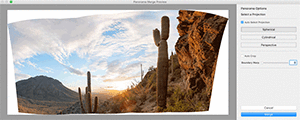 Boundary Warp attempts to fill the frame using the various content-aware technologies that Adobe has built over the past several years. Not every panoramic image will be suitable for this kind of manipulation. The sample image provided by Adobe has content that can be adjusted without visible distortion at the edges.
Boundary Warp attempts to fill the frame using the various content-aware technologies that Adobe has built over the past several years. Not every panoramic image will be suitable for this kind of manipulation. The sample image provided by Adobe has content that can be adjusted without visible distortion at the edges.
That's not to damn this feature with faint praise. The capability is simply astounding. Here's a GIF image that shows the process. Click the small image to see it full size.
In addition, Adobe has added support for several dozen lenses and fixed a bunch of bugs.
Other improvements include faster compilations of panoramic shots, better quality in the auto-straighten function, faster loading of images, tethered support for two new Nikon cameras, and the ability to specify image locations when files are being downloaded from the camera.
We have Vimeo for video perfectionists and YouTube for the masses. Users can post videos to Facebook, but apparently the company is now thinking about creating a separate service that would compete directly with YouTube and Vimeo.
In a conference call with investors and journalists this week, CEO Mark Zuckerberg said Facebook is considering "a dedicated place" where people can go "when they just want to watch videos." Zuckerberg has long been predicting that video will be a larger part of the Facebook operation.
About one billion people use Facebook every day, the majority on mobile devices. In fact, Facebook statistics show that 90% of users access Facebook on a mobile device exclusively or in conjunction with access via a computer.
The idea of a service separate from core Facebook operations came up during the call when Zuckerberg noted the success of Messenger. Messenger was split from the main service primarily to make the two services easier to use on mobile devices. Having been split from the core service, Messenger has done very well. Video might follow the same line of development.
Details of how a Facebook video service might work weren't provided because internal discussions are continuing. Video is increasingly a big part of the Internet and companies that provide video like it because participants stay longer and are exposed to more advertisements. This makes more money for the video providers.
Also, starting this week, Facebook made it possible for Apple phone users to stream live video. They're still working on an application for Android phones.